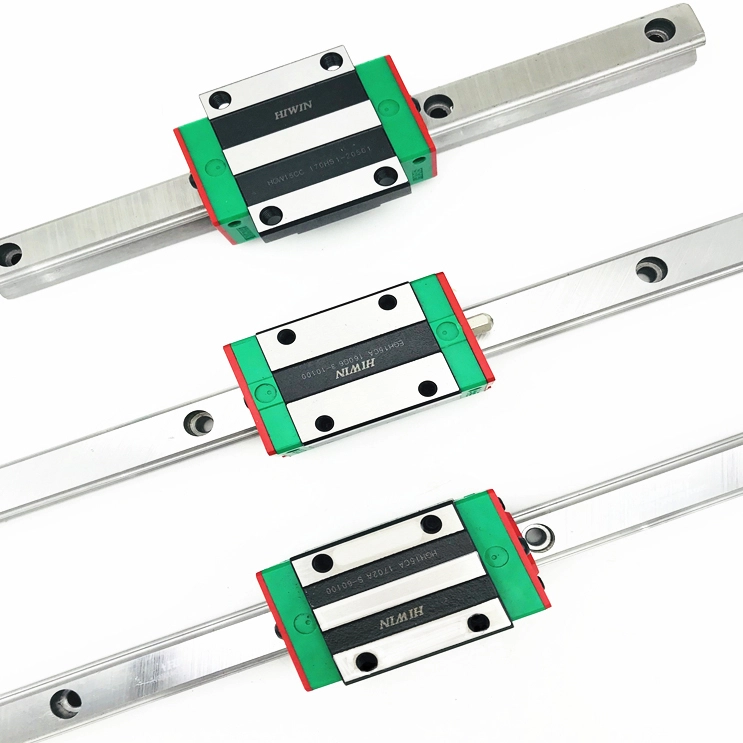Linear guides can be divided into two main groups: contact linear guides (when there is physical contact between the guide and the block) and contactless guides (when there is no contact between the two parts). The big difference between them is the wearing of the contact guides and their requisite maintenance.
1. Contact Linear Guides
1.1. Linear Guides with Roller Bearings
There are several types of linear guides with roller bearings: flat roller guides, Gothic arch guides, and V-type guides. These are rails for any type of guided movement, ensuring ease, affordability, and low maintenance (see Picture 1). One of the main features of such systems is their robustness, as dirty environments won’t affect their functioning. Another feature is their alignment tolerance, as they accept misalignments, simplifying both the workbench setup and the mounting and adjustment process. However, they have low precision, poor rigidity, and a short service life in dynamic applications due to high accelerations causing additional wear at start and braking points.
1.2. Linear Ball Bearing Guides
This type of guide is very popular due to its simple mounting. The standardization of sizes and measurements among different manufacturers has made them easily interchangeable. They offer load capacity, improved rigidity, outstanding precision, and long service life (see Picture 2). They are easy to assemble and compact, saving space on a mounting workbench. Ball chains inside the blocks reduce noise, wear, and maintenance. These guides are ideal for high-speed and high-acceleration applications. However, they require precise mounting surfaces to prevent blockages or sliding resistance due to misalignment. Regular maintenance is essential for optimal performance.
1.3. Linear Roller Guides
There are two subclasses: prismatic block guides and cross roller guides. Prismatic block guides are common in machine tool applications due to their stiffness and precision. They are easy to mount and adjust, making them popular among heavy machinery manufacturers. However, they require very precise workbenches for aligning parallel guides and cannot exceed working speeds of 2 m/s (see Picture 3/4). Cross roller guides have minimal "slip-stick" effect and are used for short stroke applications, requiring precise adjustment to prevent premature wear.
1.4. Friction Guides
These are possibly the oldest guides in engineering history. Modern synthetic materials have expanded their range and reduced costs. They are commonly applied to systems with little movement, such as format adjustments. Polymer friction guides do not require maintenance and work well in dry conditions. However, they have a high friction coefficient, limiting their use in high-speed applications and requiring larger operating mechanisms. They also show some degree of clearance, which can increase friction and wear if compensated for (see Picture 5).
2. Contactless Guides
2.1 Air Bearings
Air bearings levitate the block above the surface, offering a friction coefficient of 10^-7 and up to 300 m/s² acceleration, making them suitable for dynamic applications. They provide outstanding precision if the mounting bench is precise and flat, typically using granite workbenches. The main advantage is the lack of wear, eliminating the need for maintenance. However, they require a completely flat, roughness-free surface that is stable in temperature and deformation (see Picture 6).
2.2. Hydrostatic Guides
These are popular in machine tool applications. The space between the guide and the block is filled with a thin layer of oil, eliminating physical contact and wear. They offer high precision but require a good mounting surface and precise adjustment. Despite their high cost and low market availability, they provide excellent performance (see Picture 7).
2.3 Electromagnetic Guides
Electromagnetic guides operate on magnetic levitation principles, with repelling poles maintaining a constant gap between the guide and block. They are used in clean room or vacuum applications where other guides are unsuitable. However, their high price limits their widespread use (see Picture 8).
3. Summing Up the Main Features
Table 1 below shows the main features of the described linear guides, comparing them in terms of performance, cost, assembly, etc.
| Properties | Roller guide | Ball guide | Recircul. Roller guide | Friction guides | Air bearing | Hydrostatic guide | Electromag. Guide |
|---|---|---|---|---|---|---|---|
| Rigidity | - | + | ++ | + | + | ++ | + |
| Velocity | + | + | 0 | - | ++ | 0 | ++ |
| Acceleration | - | + | 0 | + | ++ | 0 | ++ |
| Load capacity | + | + | ++ | ++ | ++ | ++ | + |
| Precision | - | + | + | 0 | + | ++ | + |
| Ease of mounting | + | + | 0 | + | - | - | - |
| Maintenance | + | 0 | 0 | + | ++ | + | ++ |
| Cost | + | + | 0 | + | - | - | - |
That’s all for today. We hope this review of guides has been interesting, and we look forward to seeing you in the next chapter.
Additional Points
-
Energy Efficiency: Linear guides contribute to energy efficiency in machinery. Due to the low friction coefficient of the rolling elements, less energy is required to move parts, reducing overall energy consumption and operational costs. This efficiency is particularly beneficial in large-scale industrial applications where even minor improvements in energy usage can lead to substantial cost savings.
-
Customization and Versatility: Linear guides offer a high degree of customization, allowing them to be tailored to specific applications and requirements. This versatility means they can be designed to meet particular load capacities, speeds, and environmental conditions, making them suitable for a wide range of industries, from manufacturing to medical devices. The ability to customize ensures optimal performance and longevity in diverse applications.
If you wish, you may leave your comments below and subscribe to our blog so you don’t miss any publications.

